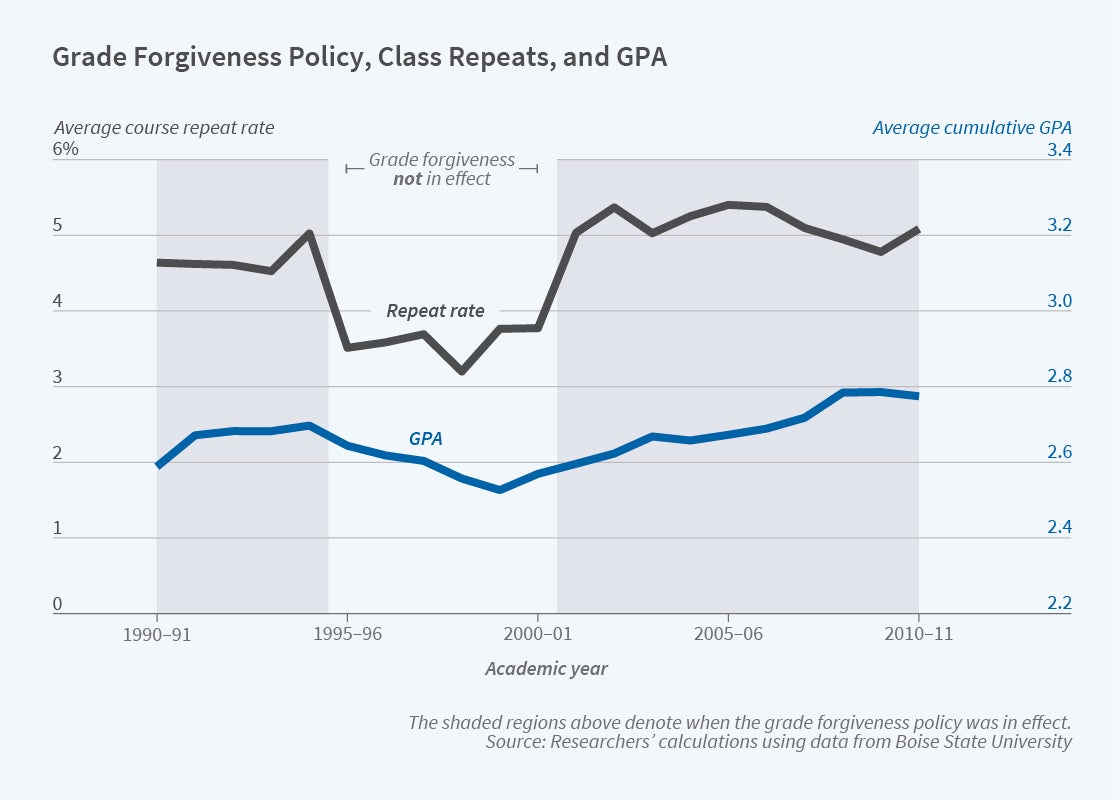The Influence of Grade Forgiveness on Students’ Course Choices

A Boise State University policy that gave students the option to retake a class and better their previous grade encouraged enrollment in more and in harder courses, especially in STEM.
Offering college students the opportunity to retake courses and to improve their grades changes course selection, according to Xuan Jiang, Kelly Chen, Zeynep K. Hansen, and Scott Lowe in A Second Chance at Success? Effects of College Grade Forgiveness Policies on Student Outcomes (NBER Working Paper 29493).
Grade forgiveness policies allow students to retake courses in which they are dissatisfied with their grades; only the most recent grade is included in their grade point average. To study the impact of such policies, the researchers looked at admission and transcript data from all entering cohorts at Boise State University between 1990 and 2017. This window presented a unique research opportunity because starting in 1988 the university offered a grade forgiveness option for all courses. In 1995, it switched to a policy of averaging the first-attempt grade and the repeat-attempt grades, and then, in 2001, it returned to grade forgiveness. It is possible to estimate the effects of grade forgiveness by comparing data from the three periods.
The researchers conclude that students were significantly more likely to repeat courses when grade forgiveness was in effect. They did so about 6 percent of the time, an increase of nearly two-thirds compared to the grade-averaging regime. Students receiving a D grade were 9.2 percent more likely to repeat the course under grade forgiveness. Those who failed were 5.97 percent more likely to repeat, and a small but significant fraction of C students also chose to repeat, suggesting some students repeat courses when they receive unsatisfying as well as failing grades. Students who withdrew from courses were significantly less likely to repeat them, and they withdrew from more courses under grade forgiveness.
Students challenged themselves more under grade forgiveness. They enrolled in more difficult courses and took classes with more stringent grading policies. They also took on heavier workloads: about 1.6 percent more courses and 1.9 percent more credits per semester. This was especially true with regard to Science, Technology, Engineering, and Mathematics (STEM) courses. Enrollment in STEM courses increased 9.5 percent under grade forgiveness. For students who had not yet declared a major, the policy increased their likelihood of enrolling in a STEM course by 10.6 percent. More students graduated with STEM degrees when grade forgiveness was in effect.
Students who repeated a course were 22 percentage points more likely to take another course in the same subject as the repeated course. The repeater students were also about 30 percentage points less likely to get a D or an F in the subsequent same-subject course, suggesting that grade forgiveness encouraged on-the-margin students to persist and progress in challenging subjects.
For women, the impact of grade forgiveness on course selection was smaller than for men, particularly with regard to STEM courses. Women were also less likely to repeat courses. The researchers suggest that the perceived cost of retaking a course — in time, effort, reduced ability to take other courses, and mental costs — deterred more women than men.
— Brett M. Rhyne


